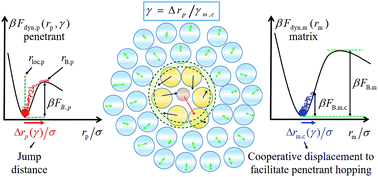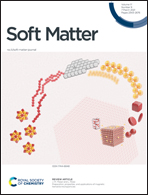Activated penetrant dynamics in glass forming liquids: size effects, decoupling, slaving, collective elasticity and correlation with matrix compressibility†
Abstract
We employ the microscopic self-consistent cooperative hopping theory of penetrant activated dynamics in glass forming viscous liquids and colloidal suspensions to address new questions over a wide range of high matrix packing fractions and penetrant-to-matrix particle size ratios. The focus is on the mean activated relaxation time of smaller tracers in a hard sphere fluid of larger particle matrices. This quantity also determines the penetrant diffusion constant and connects directly with the structural relaxation time probed in an incoherent dynamic structure factor measurement. The timescale of the non-activated fast dissipative process is also studied and is predicted to follow power laws with the contact value of the penetrant–matrix pair correlation function and the penetrant–matrix size ratio. For long time penetrant relaxation, in the relatively lower packing fraction metastable regime the local cage barriers are dominant and matrix collective elasticity effects unimportant. As packing fraction and/or penetrant size grows, much higher barriers emerge and the collective elasticity associated with the correlated matrix dynamic displacement that facilitates penetrant hopping becomes important. This results in a non-monotonic variation with packing fraction of the degree of decoupling between the matrix and penetrant alpha relaxation times. The conditions required for penetrant hopping to become slaved to the matrix alpha process are determined, which depend mainly on the penetrant to matrix particle size ratio. By analyzing the absolute and relative importance of the cage and elastic barriers we establish a mechanistic understanding of the origin of the predicted exponential growth of the penetrant hopping time with size ratio predicted at very high packing fractions. A dynamics-thermodynamics power law connection between the penetrant activation barrier and the matrix dimensionless compressibility is established as a prediction of theory, with different scaling exponents depending on whether matrix collective elasticity effects are important. Quantitative comparisons with simulations of the penetrant relaxation time, diffusion constant, and transient localization length of tracers in dense colloidal suspensions and cold viscous liquids reveal good agreements. Multiple new predictions are made that are testable via future experiments and simulations. Extension of the theoretical approach to more complex systems of high experimental interest (nonspherical molecules, semiflexible polymers, crosslinked networks) interacting via variable hard or soft repulsions and/or short range attractions is possible, including under external deformation.



 Please wait while we load your content...
Please wait while we load your content...